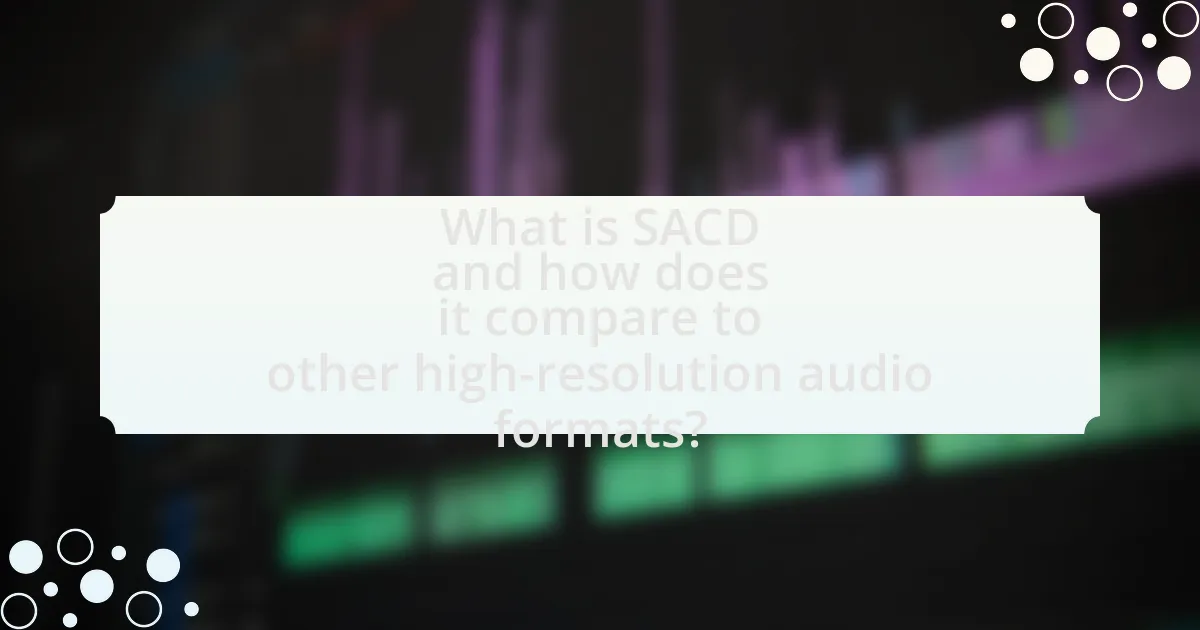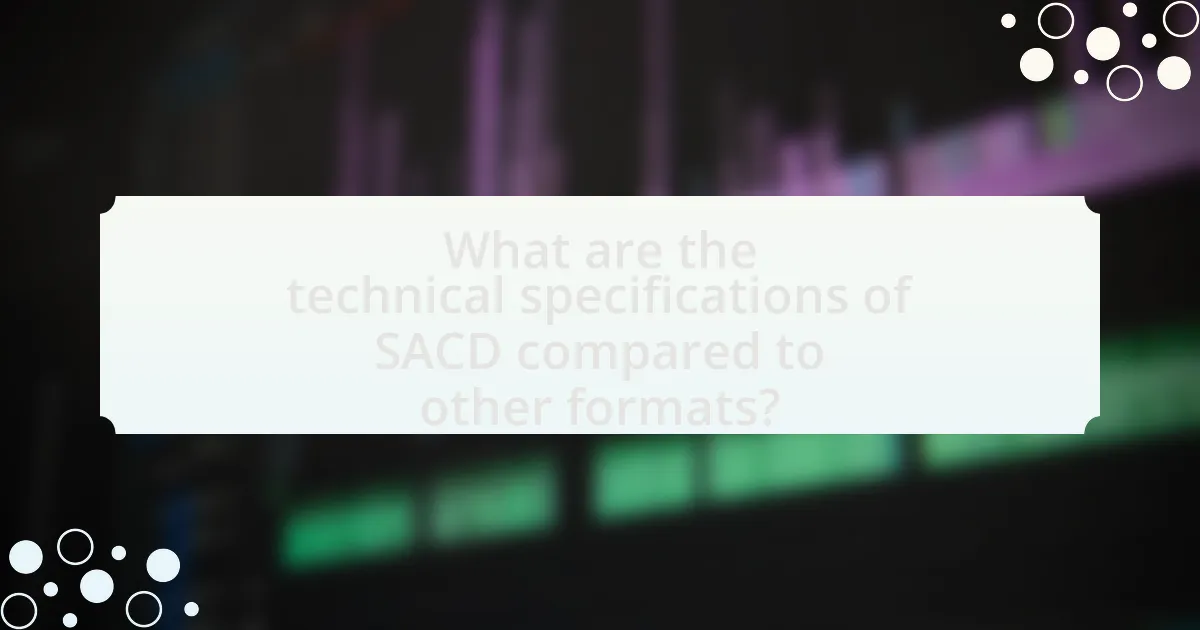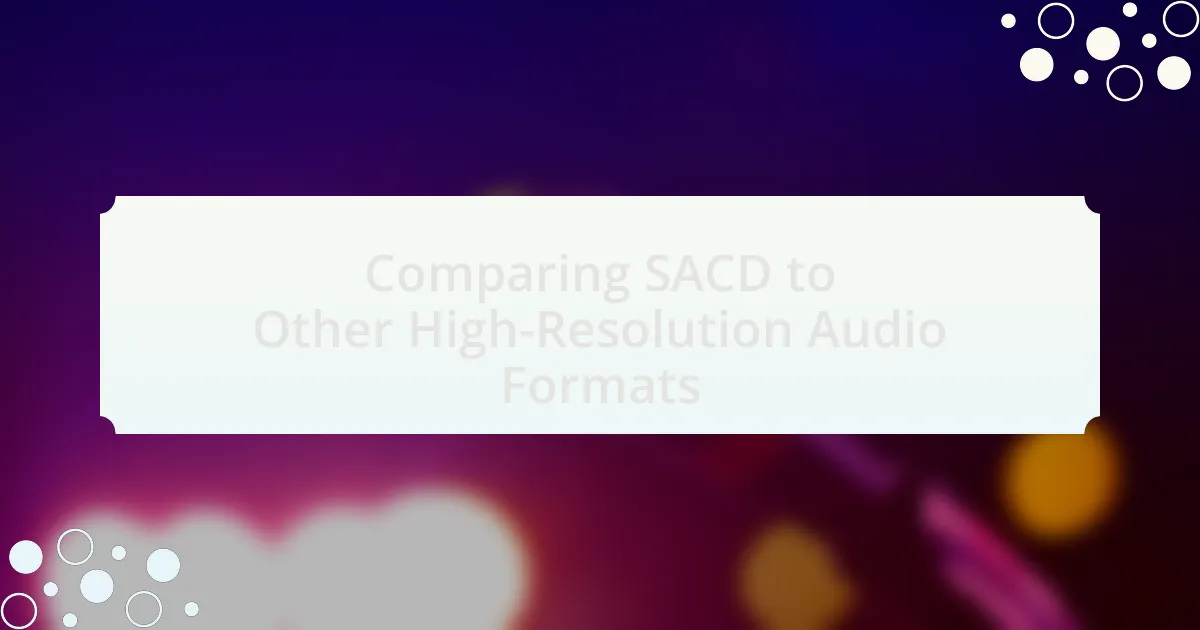SACD, or Super Audio CD, is a high-resolution audio format developed by Sony and Philips, designed to deliver superior sound quality through Direct Stream Digital (DSD) encoding. This article compares SACD to other high-resolution audio formats such as DVD-Audio and FLAC, highlighting its unique features, including multi-channel audio support and compatibility with standard CD players. It examines the technical specifications of SACD, its audio quality advantages over standard CDs, and the production processes that enhance its fidelity. Additionally, the article discusses the market presence of SACD, consumer preferences, and practical considerations for playback, providing a comprehensive overview of its position in the high-resolution audio landscape.
What is SACD and how does it compare to other high-resolution audio formats?

SACD, or Super Audio CD, is a high-resolution audio format developed by Sony and Philips, designed to provide superior sound quality compared to standard CDs. SACD employs Direct Stream Digital (DSD) encoding, which captures audio at a higher sampling rate than traditional PCM formats, resulting in a more accurate representation of the original sound.
When compared to other high-resolution audio formats like DVD-Audio and FLAC, SACD offers unique advantages such as its ability to store multi-channel audio and its compatibility with standard CD players for stereo playback. However, DVD-Audio supports higher resolution PCM audio and can include video content, while FLAC is a lossless compression format that allows for flexible file sizes and easy digital distribution. Each format has its strengths, but SACD is particularly noted for its rich sound quality and immersive listening experience.
What are the key features of SACD?
The key features of SACD (Super Audio CD) include its ability to deliver high-resolution audio through Direct Stream Digital (DSD) encoding, which provides a sampling rate of 2.8224 MHz, significantly higher than standard CDs. SACD supports multi-channel audio, allowing for immersive sound experiences with up to six channels. Additionally, SACDs can contain both high-resolution DSD audio and standard CD audio on the same disc, making them versatile for playback on different systems. The format also utilizes a robust error correction system, enhancing audio fidelity and reducing playback issues. These features collectively position SACD as a premium option in the realm of high-resolution audio formats.
How does SACD’s audio quality differ from standard CD formats?
SACD’s audio quality significantly surpasses that of standard CD formats due to its higher sampling rate and bit depth. While standard CDs use a sampling rate of 44.1 kHz and a bit depth of 16 bits, SACDs employ a Direct Stream Digital (DSD) format with a sampling rate of 2.8224 MHz, which is over 64 times higher than that of CDs. This increased resolution allows SACDs to capture a broader frequency range and greater dynamic range, resulting in a more detailed and immersive listening experience. Studies have shown that listeners often perceive SACD audio as more natural and lifelike compared to standard CDs, validating the superiority of SACD’s audio quality.
What technologies are used in SACD for sound reproduction?
SACD (Super Audio CD) utilizes Direct Stream Digital (DSD) technology for sound reproduction, which encodes audio using a 1-bit delta-sigma modulation process. This method allows for a higher sampling rate compared to traditional PCM (Pulse Code Modulation), resulting in a more accurate representation of the audio signal. DSD operates at a sampling frequency of 2.8224 MHz, which is significantly higher than the standard CD’s 44.1 kHz, enabling SACD to capture a wider frequency range and dynamic range. This technology is validated by the fact that SACD can deliver multi-channel audio, enhancing the listening experience through surround sound capabilities.
What are the other high-resolution audio formats available?
Other high-resolution audio formats available include FLAC (Free Lossless Audio Codec), ALAC (Apple Lossless Audio Codec), DSD (Direct Stream Digital), and PCM (Pulse Code Modulation). FLAC and ALAC are lossless formats that preserve audio quality while reducing file size, making them popular for music streaming and storage. DSD is used primarily in SACDs and offers a different encoding method that captures audio at a higher sampling rate. PCM is the standard form of digital audio in computers and CDs, supporting various bit depths and sample rates. These formats are recognized for their ability to deliver superior sound quality compared to standard-resolution audio formats.
How do formats like DVD-Audio and Blu-ray Audio compare to SACD?
DVD-Audio and Blu-ray Audio offer higher storage capacities and support for advanced audio formats compared to SACD. DVD-Audio can store up to 8.5 GB of audio data, allowing for higher resolution audio and additional features like video content. Blu-ray Audio significantly surpasses this, with capacities reaching up to 25 GB or more, enabling even higher fidelity audio and multi-channel sound options. In contrast, SACD typically supports a maximum of 4.7 GB for its hybrid discs, which limits its audio resolution and additional features. Furthermore, while SACD uses Direct Stream Digital (DSD) encoding, DVD-Audio and Blu-ray Audio can utilize various audio codecs, including lossless formats like Dolby TrueHD and DTS-HD Master Audio, providing flexibility in audio quality and playback options.
What are the advantages and disadvantages of each high-resolution format?
High-resolution audio formats, such as SACD, DVD-Audio, FLAC, and DSD, each have distinct advantages and disadvantages. SACD offers superior sound quality due to its DSD encoding, which captures audio at a higher sampling rate than CD, but it is limited in compatibility with standard players. DVD-Audio provides high-resolution audio and video capabilities, but its adoption has been limited, leading to fewer titles available. FLAC is widely supported and offers lossless compression, making it efficient for storage, yet it may not achieve the same audio fidelity as DSD. DSD, while providing excellent sound quality, can be less flexible in editing and processing compared to PCM formats. Each format’s specific strengths and weaknesses influence their use in high-resolution audio applications.
Why is SACD considered a premium audio format?
SACD is considered a premium audio format due to its ability to deliver high-resolution sound quality that surpasses standard CD audio. This format utilizes Direct Stream Digital (DSD) technology, which captures audio at a higher sampling rate than traditional PCM formats, resulting in greater detail and a more accurate representation of the original recording. Additionally, SACD supports multi-channel audio, allowing for immersive listening experiences that enhance the overall quality. The combination of these technical advantages, along with its use of high-quality materials in production, solidifies SACD’s status as a premium audio format.
What listening experiences does SACD provide that others may not?
SACD provides a unique listening experience characterized by its ability to deliver high-resolution audio through a multi-channel format, which enhances spatial sound and immersion. Unlike standard CDs and many other audio formats, SACD supports DSD (Direct Stream Digital) encoding, allowing for a broader dynamic range and more nuanced sound reproduction. This results in a more lifelike and engaging listening experience, particularly in multi-channel setups where sound can be positioned around the listener, creating a three-dimensional audio environment. Additionally, SACDs often include both stereo and multi-channel tracks, offering flexibility in how listeners choose to experience the music.
How does the production process of SACD impact its quality?
The production process of SACD significantly enhances its audio quality through the use of DSD (Direct Stream Digital) encoding, which captures audio at a higher sampling rate than traditional formats. This method allows for a more accurate representation of sound waves, resulting in greater detail and clarity in the final product. Additionally, the multi-layered disc structure of SACD enables both high-resolution stereo and surround sound playback, further improving the listening experience. Studies have shown that the DSD format can reproduce frequencies up to 100 kHz, which is beyond the range of human hearing, thus providing a more nuanced sound that can be appreciated in the audible spectrum.
How does SACD’s market presence compare to other formats?
SACD’s market presence is significantly smaller compared to other high-resolution audio formats like Blu-ray Audio and digital downloads. While SACD was introduced in 1999 and gained some traction among audiophiles, its sales figures have consistently lagged behind more accessible formats. For instance, as of 2021, Blu-ray Audio sales surpassed SACD sales by a considerable margin, with Blu-ray Audio benefiting from broader compatibility with modern playback systems. Additionally, digital downloads and streaming services have dominated the market, with platforms like Tidal and Qobuz offering high-resolution audio, further diminishing SACD’s relevance. This trend indicates that SACD’s niche appeal has not translated into a substantial market presence when compared to these other formats.
What trends are observed in the adoption of SACD versus other formats?
The adoption of SACD has been relatively limited compared to other high-resolution audio formats like Blu-ray Audio and digital downloads. While SACD was initially popular in the early 2000s, its market share has declined as consumers increasingly favor formats that offer greater convenience and accessibility, such as streaming services and high-resolution digital downloads. According to a report by the International Federation of the Phonographic Industry, digital music sales, including high-resolution formats, have consistently outpaced physical media sales, indicating a shift in consumer preference away from SACD.
How do consumer preferences influence the popularity of SACD?
Consumer preferences significantly influence the popularity of SACD by driving demand for high-quality audio experiences. As audiophiles and music enthusiasts increasingly prioritize superior sound quality, SACD’s ability to deliver high-resolution audio becomes appealing. Market research indicates that consumers often seek formats that enhance their listening experience, and SACD’s multi-channel capabilities and superior dynamic range cater to this desire. Additionally, the limited availability of SACD titles can create a niche market, further enhancing its appeal among dedicated listeners who value exclusivity and quality over quantity.
What are the technical specifications of SACD compared to other formats?

SACD, or Super Audio CD, features a technical specification of a maximum sampling rate of 2.8224 MHz and a bit depth of 1-bit, utilizing Direct Stream Digital (DSD) encoding. In comparison, standard CDs operate at a sampling rate of 44.1 kHz and a bit depth of 16-bit, while high-resolution formats like DVD-Audio can support sampling rates up to 192 kHz and bit depths of 24-bit. The DSD format used in SACD allows for a more nuanced representation of audio, capturing frequencies beyond the range of standard CDs, which is evidenced by its ability to reproduce sound with greater detail and dynamic range.
What is the sampling rate and bit depth of SACD?
The sampling rate of Super Audio CD (SACD) is 2.8224 MHz, and its bit depth is 1-bit. This high sampling rate is a key feature of SACD, allowing it to capture audio with greater detail compared to standard CDs, which have a sampling rate of 44.1 kHz and a bit depth of 16-bit. The 1-bit depth used in SACD is part of its Direct Stream Digital (DSD) encoding method, which provides a different approach to audio representation, enhancing the overall sound quality.
How do these specifications affect audio fidelity?
Audio fidelity is significantly influenced by specifications such as sample rate, bit depth, and channel configuration. Higher sample rates, like those used in SACD (Super Audio CD), allow for more accurate representation of sound waves, capturing higher frequencies and resulting in clearer audio. Additionally, increased bit depth enhances dynamic range, enabling more subtle nuances in sound to be reproduced, which is crucial for high-resolution formats. For instance, SACD typically employs a sample rate of 2.8224 MHz and a bit depth of 1-bit DSD (Direct Stream Digital), which provides a broader frequency response and improved detail compared to standard CD formats that use 44.1 kHz and 16-bit PCM. This technical superiority in specifications directly correlates to a more immersive listening experience, validating the preference for SACD in high-resolution audio comparisons.
What are the specifications of competing high-resolution formats?
Competing high-resolution audio formats include Super Audio CD (SACD), DVD-Audio, and Blu-ray Audio, each with distinct specifications. SACD utilizes Direct Stream Digital (DSD) encoding, offering a sampling rate of 2.8224 MHz and a bit depth of 1-bit, which provides a frequency response up to 100 kHz. DVD-Audio supports multiple audio formats, including Linear Pulse Code Modulation (LPCM) with a maximum sampling rate of 192 kHz and a bit depth of 24 bits, allowing for high-quality audio playback. Blu-ray Audio can deliver LPCM audio with sampling rates up to 192 kHz and bit depths of 24 bits, similar to DVD-Audio, but with greater storage capacity, enabling more extensive audio content. These specifications highlight the differences in audio quality and storage capabilities among the formats.
How does SACD handle multi-channel audio?
SACD, or Super Audio CD, handles multi-channel audio by utilizing a format called DSD (Direct Stream Digital), which allows for high-resolution audio playback across multiple channels, typically 5.1 surround sound. This capability enables SACD to deliver a more immersive listening experience compared to standard CDs, which are limited to stereo sound. The DSD format supports up to six channels of audio, providing a richer soundstage and greater detail in the audio reproduction. Additionally, SACD discs can contain both multi-channel and stereo tracks, allowing for versatility in playback options across different audio systems.
What are the benefits of multi-channel audio in SACD?
Multi-channel audio in SACD provides an immersive listening experience by allowing sound to be distributed across multiple channels, creating a three-dimensional soundstage. This spatial audio capability enhances the realism and depth of music, making it feel more engaging and lifelike. Additionally, multi-channel audio in SACD supports higher fidelity and dynamic range compared to traditional stereo formats, as it can utilize the full bandwidth of the medium. Studies have shown that listeners often perceive multi-channel audio as more enjoyable and emotionally impactful, which is supported by research indicating that spatial audio can improve listener satisfaction and retention of musical details.
How does this compare to multi-channel capabilities in other formats?
SACD offers superior multi-channel capabilities compared to many other high-resolution audio formats. Unlike standard CD audio, which is limited to stereo, SACD supports multi-channel audio with up to six discrete channels, providing an immersive listening experience. This is in contrast to formats like DVD-Audio, which also supports multi-channel sound but may not achieve the same level of audio fidelity due to compression methods. Additionally, Blu-ray Audio can offer multi-channel capabilities as well, but SACD’s DSD (Direct Stream Digital) encoding is often praised for its sound quality, making it a preferred choice among audiophiles.
What are the storage capacities of SACD and other formats?
The storage capacity of a Super Audio CD (SACD) is typically 4.7 GB for a single-layer disc and up to 8.5 GB for a dual-layer disc. In comparison, a standard CD holds about 700 MB, while a DVD can store 4.7 GB for single-layer and 8.5 GB for dual-layer formats. Blu-ray discs significantly increase storage capacity, with single-layer discs holding 25 GB and dual-layer discs up to 50 GB. These capacities allow SACD and other formats to accommodate high-resolution audio, with SACD supporting DSD (Direct Stream Digital) audio, which provides superior sound quality compared to standard CD audio formats.
How does the capacity influence the amount of audio content available?
The capacity of a storage medium directly influences the amount of audio content available by determining how much data can be stored. For instance, Super Audio CDs (SACDs) typically have a capacity of up to 4.7 GB for a single-layer disc, allowing for high-resolution audio tracks that can include multiple channels and longer playtime compared to standard CDs, which hold about 700 MB. This increased capacity enables SACDs to store more complex audio formats, such as DSD (Direct Stream Digital), which provides higher fidelity sound. Consequently, the greater the capacity of the medium, the more audio content, including higher quality and longer recordings, can be made available to consumers.
What are the implications of storage capacity on audio quality?
Storage capacity directly influences audio quality by determining the amount of data that can be stored and processed. Higher storage capacity allows for greater bit depth and sample rates, which enhance the dynamic range and frequency response of audio recordings. For instance, formats like SACD utilize DSD (Direct Stream Digital) technology, which requires more storage than standard CD formats, enabling higher fidelity sound reproduction. This is evidenced by the fact that SACD can store up to 6.1 MHz of audio data per channel, compared to the 44.1 kHz of standard CDs, resulting in a more detailed and nuanced listening experience.
What are the practical considerations for using SACD?

The practical considerations for using SACD include the need for compatible playback equipment, as SACD requires specific players that can read the format. Additionally, the availability of SACD titles is limited compared to other formats, which may restrict access to desired music. Furthermore, the higher production costs associated with SACD can lead to higher retail prices for consumers. These factors collectively influence the overall user experience and accessibility of SACD in comparison to other high-resolution audio formats.
What equipment is necessary to play SACD?
To play SACD, a compatible SACD player is necessary. SACD players are specifically designed to read the Super Audio CD format, which includes both high-resolution stereo and multi-channel audio. Additionally, a high-quality audio system, including an amplifier and speakers that can reproduce the enhanced audio quality of SACD, is recommended for optimal listening experience.
How do SACD players differ from standard CD players?
SACD players differ from standard CD players primarily in their ability to play high-resolution audio formats. SACD, or Super Audio CD, utilizes a different encoding method called Direct Stream Digital (DSD), which allows for a higher sampling rate and bit depth compared to the Pulse Code Modulation (PCM) used in standard CDs. This results in improved audio quality, with SACDs capable of delivering a more detailed and dynamic sound experience. Additionally, SACD players can often play both SACD and standard CD formats, while standard CD players are limited to CDs only.
What are the costs associated with SACD playback equipment?
The costs associated with SACD playback equipment typically range from $200 to over $5,000, depending on the brand, features, and audio quality. Entry-level SACD players can be found for around $200 to $500, while mid-range options generally cost between $500 and $1,500. High-end models, which often include advanced features and superior build quality, can exceed $5,000. This pricing reflects the specialized technology and components required for SACD playback, which offers higher audio fidelity compared to standard CDs and other formats.
What are the best practices for enjoying SACD?
To enjoy SACD (Super Audio CD) effectively, use a high-quality SACD player that supports both SACD and standard CD formats. This ensures optimal playback of the high-resolution audio that SACDs offer. Additionally, connect the player to a high-fidelity audio system with quality speakers and amplifiers to fully appreciate the enhanced sound quality. It is also beneficial to use high-quality interconnects and speaker cables to minimize signal loss. Listening in a well-treated room can further enhance the audio experience by reducing unwanted reflections and improving clarity. Finally, select a diverse range of SACD titles that showcase different genres and recording techniques to explore the full capabilities of the format.
How can listeners optimize their setup for SACD playback?
Listeners can optimize their setup for SACD playback by ensuring they use a dedicated SACD player or a universal player that supports SACD formats. This is crucial because SACD requires specific hardware to decode its DSD (Direct Stream Digital) audio format, which standard CD players cannot process. Additionally, connecting the player to a high-quality audio system with a capable DAC (Digital-to-Analog Converter) enhances sound quality, as many SACD players have superior built-in DACs designed for high-resolution audio. Using high-quality interconnects and ensuring proper speaker placement further improves the listening experience, as these factors contribute to the overall fidelity and spatial accuracy of the sound.
What tips can enhance the listening experience with SACD?
To enhance the listening experience with SACD, ensure you use a high-quality SACD player that supports both stereo and multi-channel formats. A dedicated SACD player is designed to fully utilize the high-resolution audio capabilities of SACD discs, providing superior sound quality compared to standard CD players. Additionally, invest in a good set of speakers and an appropriate amplifier, as these components significantly affect audio fidelity. Proper room acoustics also play a crucial role; consider soundproofing and speaker placement to minimize reflections and optimize soundstage. Lastly, select high-quality SACD recordings, as the source material directly impacts the listening experience.
What challenges do users face when transitioning to SACD?
Users face several challenges when transitioning to SACD, primarily related to compatibility and accessibility. Many existing audio systems do not support SACD playback, requiring users to invest in new hardware, such as SACD players or compatible receivers. Additionally, the limited availability of SACD titles compared to other formats like CD or digital downloads can hinder users’ ability to build a diverse library. Furthermore, the complexity of the SACD format, which includes both stereo and multi-channel options, can be confusing for users unfamiliar with high-resolution audio. These challenges highlight the need for users to adapt their equipment and expectations when moving to SACD from more common audio formats.
How can users overcome compatibility issues with SACD?
Users can overcome compatibility issues with SACD by ensuring they have a compatible player that supports both SACD and standard CD formats. Many modern audio players and home theater systems are designed to handle SACD playback, but users should verify specifications to confirm compatibility. Additionally, utilizing an HDMI connection can enhance compatibility, as it allows for the transfer of high-resolution audio signals. According to the Super Audio CD specification, SACD discs can contain a CD layer, which ensures playback on standard CD players, thus providing a fallback option for users facing compatibility challenges.
What are common misconceptions about SACD that users should be aware of?
Common misconceptions about SACD include the belief that it is only a format for classical music, that it offers no significant audio improvement over standard CDs, and that all SACD players can play all SACD discs. In reality, SACD is versatile and supports various genres, including rock and jazz. Additionally, SACD utilizes DSD (Direct Stream Digital) technology, which can provide superior sound quality compared to CDs, particularly in terms of dynamic range and frequency response. Furthermore, not all SACD players are compatible with every SACD disc, as some discs are hybrid (containing both SACD and CD layers) while others are single-layer SACDs, which require specific player capabilities for playback.

Leave a Reply